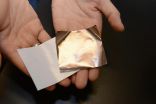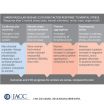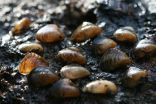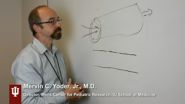INFORMATION:
The National Science Foundation supported this work.
Tailored flexible illusion coatings hide objects from detection
2014-10-13
(Press-News.org) Developing the cloak of invisibility would be wonderful, but sometimes simply making an object appear to be something else will do the trick, according to Penn State electrical engineers.
"Previous attempts at cloaking using a single metasurface layer were restricted to very small-sized objects," said Zhi Hao Jiang, postdoctoral fellow in electrical engineering, Penn State. "Also, the act of cloaking would prevent an enclosed antenna or sensor from communicating with the outside world."
Jiang and Douglas H. Werner, John L. and Genevieve H. McCain Chair Professor of Electrical Engineering, developed a metamaterial coating with a negligible thickness that allows coated objects to function normally while appearing as something other than what they really are, or even completely disappearing. They report their research in Advanced Functional Materials.
The researchers employ what they call "illusion coatings," coatings made up of a thin flexible substrate with copper patterns designed to create the desired result. They can take a practical size metal antenna or sensor, coat it with the patterned film and when the device is probed by a radio frequency source, the scattering signature of the enclosed object will appear to be that of a prescribed dielectric material like silicon or Teflon. Conversely, with the proper pattern, they can coat a dielectric and it will scatter electromagnetic waves the same as if it were a metal object.
"The demonstrated illusion/cloaking coating is a lightweight two-dimensional metasurface, not a bulky three-dimensional metasurface," said Werner.
The researchers take the object they want cloaked and surround it with a spacer, either air or foam. They then apply the ultrathin layer of dielectric with copper patterning designed for the wavelengths they wish to cloak. In this way, antennae and sensors could be made invisible or deceptive to remote inspection.
Another application of this material would be to protect objects from other emitting objects nearby while still allowing electromagnetic communication between them. This was not possible with the conventional transformation optics-based cloaking method because the cloaking mechanism electromagnetically blocked the cloaked object from the outside, but this new coating allows the object surrounded to continue working while being protected. In an array of antennae, for example, interference from the nearby antennas can be suppressed.
The metasurface coating consists of a series of copper, geometric patterns placed on a flexible substrate using standard lithographic methods currently used to create printed circuit boards. Each illusion coating must be designed for the specific application, but the designs are optimized mathematically. This method of manufacture is low cost and well established.
Another advantage of this method is that it works not only for direct hits by radio frequency waves incident normally on the coated object, but also continues to operate properly within a 20 degree field of view, making it a better angle-tolerant shield than previous attempts that employed bulky metamaterials. Currently, the metasurface coatings only work on narrow bands of the spectrum for any application, but can be adapted to work in other bands of the electromagnetic spectrum including the visible spectrum.
"We haven't tried expanding the bandwidth yet," said Werner. "But the theory suggests that it should be possible and it will probably require multiple layers with different patterns to do that."
Illusion coatings could be used for things other than hiding. They could enhance the way radio frequency ID tags work or could redistribute energy in different, controlled patterns making things more visible rather than less visible. The materials shielding ability can also be used to protect any type of equipment from stray or intentional electromagnetic interference.
ELSE PRESS RELEASES FROM THIS DATE:
Stanford scientists create a 'smart' lithium-ion battery that warns of fire hazard
2014-10-13
Stanford University scientists have developed a "smart" lithium-ion battery that gives ample warning before it overheats and bursts into flames.
The new technology is designed for conventional lithium-ion batteries now used in billions of cellphones, laptops and other electronic devices, as well as a growing number of cars and airplanes.
"Our goal is to create an early-warning system that saves lives and property," said Yi Cui, an associate professor of materials science and engineering at Stanford. "The system can detect problems that occur during the normal operation ...
Digital divide: Pediatricians debate whether tots should have access to electronic devices
2014-10-13
SAN DIEGO – When the American Academy of Pediatrics (AAP) published its policy statement in 1999 discouraging electronic media use by children under 2, the focus was on television programs, videos and DVDs.
Over the past 15 years, the technology landscape has changed dramatically. Toddlers now have access to a dizzying array of touchscreen devices that are available anywhere and everywhere. Although the AAP has revised its media use policy over the years based on the latest research, the message regarding toddlers' exposure to screens is the same.
Given the ...
Impact of mental stress on heart varies between men, women
2014-10-13
WASHINGTON (Oct. 13, 2014) — Men and women have different cardiovascular and psychological reactions to mental stress, according to a study of men and women who were already being treated for heart disease. The study, published today in the Journal of the American College of Cardiology, looked at 56 women and 254 men diagnosed with heart disease enrolled in a larger REMIT study of the impact of the medication escitalopram on heart disease induced by mental stress.
After undergoing baseline testing, participants carried out three mentally stressful tasks — ...
Britain on brink of freshwater species 'invasion' from south east Europe
2014-10-13
Five of the most high-risk freshwater invaders from the Ponto-Caspian region around Turkey and Ukraine are now in Britain - including the quagga mussel, confirmed just two weeks ago on 1 October in the Wraysbury River near Heathrow airport.
Researchers say that, with at least ten more of these high-risk species established just across the channel in Dutch ports, Britain could be on the brink of what they describe as an 'invasional meltdown': as positive interactions between invading species cause booming populations that colonise ecosystems - with devastating consequences ...
Hillary Rodham Clinton to unveil early literacy toolkit for pediatricians and parents
2014-10-13
SAN DIEGO – Former Secretary of State Hillary Rodham Clinton will discuss the role that pediatricians and parents can play in promoting young children's early learning during her remarks on Sunday Oct. 12 at the American Academy of Pediatrics (AAP) National Conference & Exhibition in San Diego. Secretary Clinton will announce the launch of the Academy's updated early literacy toolkit for pediatricians and parents, Books Build Connections, which will be shared with its 62,000 pediatrician members immediately following Secretary Clinton's remarks.
In June 2014, the ...
A novel platform for future spintronic technologies
2014-10-12
Spintronics is an emerging field of technology where devices work by manipulating the spin of electrons rather than their charge. The field can bring significant advantages to computer technology, combining higher speeds with lower energy consumption. Spintronic circuits need ways to control electron spin without interference from electron charge. Scientists at EPFL, working with Université Paris-Sud and Paul Scherrer Institut, have discovered that a common insulating material behaves as a perfect spintronic conductor because it is not affected by background electron ...
Novel culture system replicates course of Alzheimer's disease, confirms amyloid hypothesis
2014-10-12
An innovative laboratory culture system has succeeded, for the first time, in reproducing the full course of events underlying the development of Alzheimer's disease. Using the system they developed, investigators from the Genetics and Aging Research Unit at Massachusetts General Hospital (MGH) now provide the first clear evidence supporting the hypothesis that deposition of beta-amyloid plaques in the brain is the first step in a cascade leading to the devastating neurodegenerative disease. They also identify the essential role in that process of an enzyme, inhibition ...
Icebergs once drifted to Florida, new climate model suggests
2014-10-12
AMHERST, Mass. – Using a first-of-its-kind, high-resolution numerical model to describe ocean circulation during the last ice age about 21,000 year ago, oceanographer Alan Condron of the University of Massachusetts Amherst has shown that icebergs and meltwater from the North American ice sheet would have regularly reached South Carolina and even southern Florida. The models are supported by the discovery of iceberg scour marks on the sea floor along the entire continental shelf.
Such a view of past meltwater and iceberg movement implies that the mechanisms of abrupt ...
Researchers develop new cells meant to form blood vessels, treat peripheral artery disease
2014-10-12
VIDEO:
Researchers have developed a technique to jump-start the body's systems for creating blood vessels, opening the door for potential new treatments for diseases whose impacts include amputation and blindness....
Click here for more information.
INDIANAPOLIS -- Researchers have developed a technique to jump-start the body's systems for creating blood vessels, opening the door for potential new treatments for diseases whose impacts include amputation and blindness.
The ...
Revving up fluorescence for superfast LEDs
2014-10-12
DURHAM, N.C. -- Duke University researchers have made fluorescent molecules emit photons of light 1,000 times faster than normal -- setting a speed record and making an important step toward realizing superfast light emitting diodes (LEDs) and quantum cryptography.
This year's Nobel Prize in physics was awarded for the discovery of how to make blue LEDs, allowing everything from more efficient light bulbs to video screens. While the discovery has had an enormous impact on lighting and displays, the slow speed with which LEDs can be turned on and off has limited their ...





